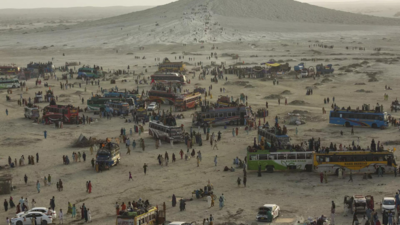
Pilgrims, arriving by bus, camp overnight on the desert plain in front of the Chandragup mud volcano during their journey to the Hinglaj Devi temple in the Balochistan Province of Pakistan, May 1, 2025. (NYT News Service)
HINGOL NATIONAL PARK, PAKISTAN: When Amar Faqira's 3-year-old son abruptly lost movement in his foot last year, doctors offered little hope. As panic gripped his family, Faqira made a vow - if the boy recovered, he would make a 200-mile pilgrimage through blistering plains and jagged terrain to the Hinglaj Devi temple, a site sacred to the Hindu minority in Pakistan.
It is also where Pakistan's largest annual Hindu festival is held, usually in mid-April.When the child regained strength a year later, Faqira set off in late April on a seven-day walk to the temple, nestled deep in the rust-coloured mountains of the restive Balochistan. The goddess "heard me and healed my son," Faqira said before the trek, as he gathered with friends and family in his neighbourhood in Karachi. "Why shouldn't I fulfill my vow and endure a little pain?"Faqira and two companions, wearing saffron headscarves and carrying a ceremonial flag, joined thousands of others on the gruelling journey to Hinglaj Devi.
Along a winding highway and sun-scorched desert paths, groups of resolute pilgrims - mostly men but also women and children - trudged beneath the unforgiving sky, in heat that reached 45Celsius. Some bore idols of the deity, and all chanted "Jai Mata Di" .The pilgrimage is an act of spiritual devotion as well as cultural preservation. Pakistan's Hindus number about 4.4 million and make up less than 2% of the country's population, which is more than 96% Muslim.
Hindus are often treated as second-class citizens, systemically discriminated against in housing, jobs and access to govt welfare.For many, the pilgrimage to Hinglaj Devi is comparable in significance to the Haj in Islam, a once-in-a-lifetime obligation of faith. The yearning to make the journey is also strong among Hindus in India though it is very difficult for Indians to receive visas to travel to Pakistan. States bordering Pakistan have deep spiritual links to Hinglaj Devi that are rooted in traditions predating the Partition.For much of the 20th century, the Hinglaj Devi temple remained inaccessible. The pilgrimage gained momentum only in the 1990s. A transformative shift came in the early 2000s with the construction of the Makran Coastal Highway, which links the rest of Pakistan to the Chinese-operated Gwadar deep-sea port. The highway brought unprecedented access to the temple -- it became possible to make the bulk of the journey by vehicle, taking some of the sweat out of the endeavour.
Still, thousands continue to make the journey by foot. They are considered the more spiritually devoted. "The real pilgrimage is in the pain, the feeling," said Faqira on the fourth day of his trek. One of his two companions collapsed from heat exhaustion after walking nearly 70 miles and had to return home by bus. Faqira carried on, his feet blistered and bandaged. Each pilgrim walks with a personal vow.Minakshi, part of a group of women dressed in yellow and red, undertook the journey to ask the goddess for a son.
Nearby, 60-year-old Raj Kumari was making her seventh pilgrimage, praying for her grandson's well-being. Also on the trek was a childless couple, married since 2018. Hinglaj Devi temple is one of the sites where the remains of Sati, goddess of marital devotion and longevity, fell to Earth after her self-immolation. For many of the faithful, the pilgrimage begins with a symbolic trek to a sacred mud volcano rising from the barren landscape near the Makran Coastal Highway.
At the summit, devotees toss coconuts and rose petals into the bubbling crater to seek divine permission to proceed.
Many also smear volcanic clay on their faces and bodies. The next stage takes pilgrims to the Hingol River for a ritual bath. From there, they continue 28 miles to the Hinglaj Devi temple, set within a natural cave.The complex houses four shrines, the most revered being the Nani Mandir. After reaching the shrines, devotees complete the pilgrimage with an arduous, hourslong trek across seven mountains, before returning to the temple to pray.

 1 day ago
38
1 day ago
38




























 English (US)
English (US)